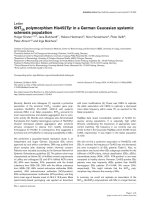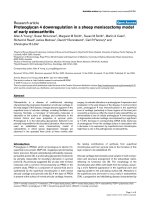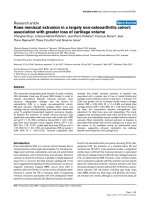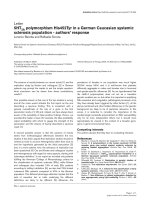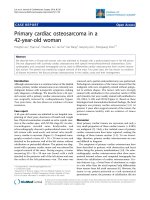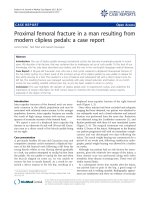Báo cáo y học: "Emergency intraosseous access in a helicopter emergency medical service: a retrospective study"
Bạn đang xem bản rút gọn của tài liệu. Xem và tải ngay bản đầy đủ của tài liệu tại đây (236.45 KB, 5 trang )
ORIGINAL RESEARCH Open Access
Emergency intraosseous access in a helicopter
emergency medical service: a retrospective study
Geir A Sunde
1,2*
, Bård E Heradstveit
1,2
, Bjarne H Vikenes
1,2
, Jon K Heltne
1,2,3
Abstract
Background: Intraosseous access (IO) is a method for providing vascular access in out-of-hospital resuscitation of
critically ill and injured patients when traditional intravenous access is difficult or impossible. Different intraosseous
techniques have been used by our Helicopter Emergency Medical Services (HEMS) since 2003. Few articles
document IO use by HEMS physicians. The aim of this study was to evaluate the use of intraosseous access in pre-
hospital emergency situations handled by our HEMS.
Methods: We reviewed all medical records from the period May 2003 to April 2010, and compared three different
techniques: Bone Injection Gun (B.I.G® - Waismed), manual bone marrow aspiration needle (Inter V - Medical Device
Technologies) and EZ-IO® (Vidacare), used on both adults and paediatric patients.
Results: During this seven-year period, 78 insertion attempts were made on 70 patients. Overall success rates were
50% using the manual needle, 55% using the Bone Injection Gun, and 96% using the EZ-IO®. Rates of success on
first attempt were significantly higher using the EZ-IO® compared to the manual needle/Bone Injection Gun (p <
0.01/p < 0.001). Fifteen failures were due to insertion-related problems (19.2%), with four technical problems (5.1%)
and three extravasations (3.8%) being the most frequent causes. Intraosseous access was primarily used in
connection with 53 patients in cardiac arrest (75.7%), including traumatic arrest, drowning and SIDS. Other
diagnoses were seven patients with multi-trauma (10.0%), five with seizures/epilepsy (7.1%), three with respiratory
failure (4.3%) and two others (2.9%). Nearly one third of all insertions (n = 22) were made in patients younger than
two years. No cases of osteomyelitis or other serious complications were documented on the follow-up.
Conclusions: Newer intraosseous techniques may enable faster and more reliable vascular access, and this can
lower the threshold for intraosseous access on both adult and paediatric patients in critical situations. We believe
that all emergency services that handle critically ill or injured paediatric and adult patients should be familiar with
intraosseous techniques.
Background
Vascular access is important in the resuscitation of criti-
cally ill or injured adult and paediatric patients [1,2]. It
can be challenging to obtain vascular access, especially
in the resuscitation of small children in emergency
situations [3-5]. The European Resuscitation Council
2005 guidelines [6] and International Liaison Committee
on Resuscitation guidelines [4] recommend intraosseous
access during resuscitation if intravenous access proves
to be difficult or impossible. Despite these recommenda-
tions, intraosseous techniques appear to be rarely used
[7]. While numerous reports have been published about
the use of different intraosseous devices in emergency
patients, they are primarily from paramedic-based
ambulance services [2,8]. Few comparisons have been
published of different IO techniques used by physicians
in emergency departments [7] or in HEMS services
manned by physicians/nurses [9,10].
Typical HEMS operating conditions make special
demands on medical equipment such as IO devices.
Rain, cold, darkness and non-sterile conditions mean
that such equipment must be durable and simple to use
in all conditions. User friendliness is important for res-
cuers, both on-scene and in-flight [10].
Intravenous access is traditionally regarded as the
optimal route for medication and fluids, and the
* Correspondence:
1
Department of Anaesthesia and Intensive Care, Haukeland University
Hospital, Bergen, Norway
Full list of author information is available at the end of the article
Sunde et al. Scandinavian Journal of Trauma, Resuscitation and Emergency Medicine 2010, 18:52
/>© 2010 Sunde et al; licensee BioMed Central Ltd. This is an Open Access article distributed under the terms of the Creative Commons
Attribution License ( which permits unrestricted use, distribution, and reproduction in
any medium, provided the original work is properly cited.
intraosseous route is often described as the best alterna-
tive choice [3,4,11]. Endotracheal, umbilical or intracar-
dial routes are poorer alternatives as regards speed of
insertion and reliability in emergency resuscitation.
Great saphenous vein cutdown as an emergency surgical
approach has also been replaced by the faster IO techni-
que [3,12]. In newborn resuscitation, umbilical venous
access is often preferred, with intraosseous as an alter-
native route [12,13].
Intraosseous technique has been described as a simple
and reliable method in both cadaver and clinical studies
[9,11,14]. The aim of this study was to evaluate the use
of intraosseous access in emergency situations handled
by physicians in a pre-hospital HEMS service.
Methods
Our HEMS helicopter and rapid response vehicle are
based at the regional university hospital. The HEMS
covers an area of about 15,500 square kilometres of
Western Norway, with a population of approximately
500,000. The majority (97%) of missions are ‘code red’
emergencies [15] and involve medical (65%) and trauma
(35%) cases, including incubator transport. During the
study period, the HEMS treated 6,116 patients in total,
10.6% of whom were younger than six years.
The HEMS is staffed by six consultants and one regis-
trar. All are experienced anaesthesiologists with extensive
knowledge of establishing intravenous access, in both
peripheral and central lines, in critically ill patients in
emergency situations. As part of their HEMS training
programme, intraosseous training was given using man-
ual needles, Bone Injection Guns, and EZ-IO® on both
manikins and cadavers. All HEMS physicians have used
the technique on patients during resuscitations. The
devices were mainly used on-scene before commencing
transport, but some insertions were made en route to the
hospital (in the helicopter or ambulance) or after arrival
at the emergency department. The equipment used in
this study has been standard issue for our HEMS service.
Our study population included adult and paediatric
emergency patients on whom IO access was performed
or attempted by our HEMS unit between May 2003 and
April 2010. Data collection was based on a retrospective
review of all medical records, and we compared three
techniques (B.I.G®, Manual needle and EZ-IO®) in rela-
tion to insertion success rates, insertion-related pro-
blems and complications, insertion site, patient age
ranges and presenting diagnosis. Age stratification was
chosen to differentiate small children, pre-school chil-
dren, older children and adults (Table 1). Follow up of
in-hospital records was done to document complica-
tions, needle removal times, antibiotics and outcome.
In the period 2003 to 2006, we used the B.I.G® (Bone
Injection Gun - Waismed) for adult patients and a
manual bone marrow aspiration needle (Inter-V - Medi-
cal Device Technologies) for paediatric patients. Since
2006, we have used the EZ-IO® (Vidacare) for all
patients.
This study was not subject to approval by the Regional
Committee for Medical Research Ethics but was sub-
mitted there for evaluation, and they had no objections
to the study or the results being published.
Study data were collected in a separate research data-
base. Rates of success for the different devices were
compared using exact Chi-square tests. Contrast
between groups for success on first attempt and total
success was calculated, and presented with 95% CI.All
statistical analyses were performed using SPSS version
17.0 (SPSS Inc., Chicago, IL, USA) and Statistical Analy-
sis System (SAS) version 0.2 software for Windows (SAS
Institute, Inc., Cary, North Carolina). Exact confidence
intervals were obtained by using the PROF FREQ proce-
dure in SAS. A p-value < 0.05 was considered
significant.
Results
IO insertion success rates
During the seven-year period, 78 insertion attempts
were made on 70 patients. Overall success rates for the
different methods were 50% using the manual needle,
55% using the Bone Injection Gun, and 96% using the
EZ-IO®. Insertion success data for each device are pre-
sented in Table 2. Rates of success on first attempt were
significantly higher using the EZ-IO® compared to the
manual needle/Bone Injection Gun (p < 0.01/p < 0.001).
We found no reduction in failure rates over time for
each device. Apart from the manual needle (where small
numbers are confounding), the B.I.G® showed consistent
annual failure rates of 43 to 50% over three years. The
EZ-IO® showed failure rates of 5 to 8% in its third and
fourth years of service, and zero failure rates in the first,
second and fifth years. Insertion failures were equally
distributed among the physicians involved.
Insertion-related problems and complications
Fifteen failures were due to insertion-related problems
(19.2%), with four technical problems (5.1%) and three
Table 1 IO distribution according to patient age:
Patient
age
Number of
patients
who recieved IO
Total number
of
patients
treated
IO insertion
rate
%
0-2 years 18 453 3.97%
3-6 years 0 198 0.00%
7-17 years 5 486 1.03%
18-78 years 47 4979 0.94%
IO - Intraosseous.
Sunde et al. Scandinavian Journal of Trauma, Resuscitation and Emergency Medicine 2010, 18:52
/>Page 2 of 5
extravasations (3.8%) being the most frequent causes.
With the manual needle, we registered one case of nee-
dle bending and one case of extravasation. Technical
complications such as the bending of needles, malfunc-
tion of equipment and misplacement of needles were
registered in three cases using the B.I.G®. Iatrogenic
fracture of the bone at the insertion site with subse-
quent extravasation happened once with the B.I.G®. No
technical problems were encountered with the EZ-IO®.
One accidental dislocation of needle (EZ-IO®) was regis-
tered in the intensive care unit, and one case of extrava-
sation due to the EZ-IO® being inserted into a traumatic
fractured tibia was documented.
Insertion site
Forty-six of the insertions (59.0%) were made in the
proximal tibia. Three were made in the proximal
humerus (3.8)%. In the 29 remaining cases, the insertion
site was not registered (37.2%).
Patient age ranges
Patients ranged from one week to 78 years old. Nearly
one third of all insertions (n = 22) were made in
patients younger than two years. Intraosseous use by
age is presented in Table 1.
Presenting diagnosis
Intraosseous access was primarily used in connection
with 53 patients in cardiac arrest (75.7%), including
traumatic arrest, drowning and SIDS. Other diagnoses
were seven patients with multi-trauma (10.0%), five with
seizures/epilepsy (7.1%), three with respiratory failure
(4.3%) and two others (2.9%). Intraosseous access was
used in 4.8% of all cardiac arrests (n = 1099) and in
1.3% of all non-arrest trauma patients (n = 549). In
those younger than two years who received IO, 13
patients (72%) were in cardiac arrest.
Follow up
Of the 70 patients included, 40 patients (57%) survived
to hospital admission and only 12 patients (17%) sur-
vived to hospital discharge. Only half of the patients
(50%) received antibiotics during the hospital stay as
treatment for other medical conditions, despite the
recommendation of one prophylactic dose to all IO trea-
ted patients. IO needles were removed within two hours
of hospital admittance in seven patients. Needle removal
times for the remaining patients were not documented.
No cases of osteomyelitis or other serious complications
were documented during the follow-up of hospital
records.
Discussion
NewerintraosseoustechniquessuchastheEZ-IO®
enable faster and more reliable emergency vascular
access than the older spring-loaded and manual techni-
ques in our study. In our opinion, this may lower the
threshold for using intraosseous access in emergency
situations. IO is particular useful in pre-hospital paedia-
tric emergencies where IV access may be impossible.
The small series, especially the low number of manual
insertions, and the retrospective design are limitations
in our study. Comparison of devices over different time
frames may cause bias in interpretation of the results.
Nonetheless, as the different techniques were used by
the same medical crews, on the same type of patients,
and on the same indications - we believe that the differ-
ences in time frames do not confound the conclusions.
Also, the limited number of physicians involved ensures
high reliability in relation to the different techniques
used.
All our IO insertions were done by field anaesthesiolo-
gists with experience of establishing IV access in emer-
gency patients. Paramedic or nurse-based EMS units
often report higher IO insertion rates [2]. Intraosseous
Table 2 Insertion data and success rates with manual needle, B.I.G. and EZ-IO:
IO
device
Number of patients
who recieved IO
Number of
insertions
Success on
1. attempt
Success on
2. attempt
Success on
3. attempt
Failed
insertions
First attempt
success ** (95%CI)
Overall success
*** (95%CI)
Manual
needle
5* 6 2 1 0 3 40% (5-85) 50% (12-88)
B.I.G. 18* 22 10 1 1 10 56% (31-79) 55% (32-76)
EZ-IO 49 50 47 1 0 2 96% (86-100) 96% (86-100)
Total
number
70* 78 59 3 1 15 84% 81%
Successes on first attempt were compared using exact chi-square test. The contrasts between EZ-IO® and the manual needle/Bone Injection Gun were significant
(p < 0.01/p < 0.001). Manual needle vs. B.I.G. was not significant (p = 0.64).
* Two patients had the first attempt with a Manual needle, and the second attempt with a B.I.G.
** First attempt success is calculated using the “Success on 1. attempt” related to “Number of patients who received IO”. *** Overall success is calculated using
all successful attempts related to “Number of insertions”.
IO - Intraosseous.
Sunde et al. Scandinavian Journal of Trauma, Resuscitation and Emergency Medicine 2010, 18:52
/>Page 3 of 5
technique may be used more frequently for vascular
access in less experienced emergency services. The low
intervention rate of inserted IO in our study supports
this view, and this rate is comparable with results from
other physician-staffed HEMS services [9,14,16].
In relation to the Bone Injection Gun, some studies
have shown impressive insertion success rates of
between 91% and 100% [2,17]. We found consistent low
success rates with the B.I.G®, with insertion failures
equally distributed among the physicians. The rotation
of staff and acquired device experience did not seem to
influence these results. The overall success rate with the
B.I.G® in our material was only 55%, and we believe that
this is not good enough when better alternatives are
available. Other reports support our finding that physi-
cians achieve lower success rates using this technique
[14,18].
Several studies have shown high insertion success
rates using the EZ-IO® [8,19], as well as fast and easy
insertions [20]. This indicates user friendliness and con-
firms our results [11]. The development of new powered
techniques may increase the rate of successful intraoss-
eous access.
We believe paediatric resuscitation may benefit most
from IO use [12]. Intraosseous access compares favour-
ably with umbilical venous catheterisation in newborn
vascular access models [21] and reduces vascular access
time during infant resuscitation [22]. We used IO to a
greater extent in paediatric than in adult patients. Our
results support the recommendation of intraosseous
access as the primary choice for vascular access during
the resuscitation of children under two years of age. In
older children and adults, the IO technique should be
reserved as a rescue technique.
The use of IO as a bridging technique, either pre-hos-
pital or in the emergency department, has recently been
described [23]. IO can facilitate speedier administration
of medication, blood or fluids, thereby increasing patient
safety (even after arriving at the hospital) [23,24].
Failed IO access was mainly due to insertion-related
problems, with technical problems and extravasation as
the most frequent causes. The local fracture experienced
using the B.I.G® has also been reported by others
[25,26]. Few registered complications in our study may
indicate that intraosseous access is a reasonably safe res-
cue method considering the circumstances in which it is
used. However, infections may develop later during
treatment, but none were found during follow-up
despite non-sterile insertion conditions.
The proximal tibia was the dominant site chosen for
intraosseous access, due to the advantage that it does
not interfere with ongoing cardiopulmonary resuscita-
tion [1,27].
The most important clinical implications of newer
powered devices for IO access relate to critically ill pae-
diatric patients and emergency department resuscita-
tions as a bridging technique when intravenous access
cannot readily be achieved. Rates of success on first
attempt are important when comparing different techni-
ques. Structured mandatory training in this rescue tech-
nique must be emphasised [28].
Conclusions
Newer intraosseous techniques may enable faster and
more reliable vascular access. This can lower the thresh-
old for using intraosseous access techniques on both
adult and paediatric patients in critical situations. We
believe that all emergency services that handle critically
ill or injured patients should be familiar with intraoss-
eous techniques. Further studies are warranted to estab-
lish the role of intraosseous access as an emergency
rescue technique.
List of abbreviations
IO: Intraosseous; HEMS: Helicopter Emergency Medical
Service; SIDS: Sudden Infant Death Syndrome; IV: Intra-
venous; EMS: Emergency Medical Service.
Affiliations
All the authors are employed at the regional university
hospital (Haukeland University Hospital), which is part
of a national health trust. This study received no exter-
nal financial support or grants.
Acknowledgements
The authors would like to thank Statistician Roy M Nilsen at the Clinical
Research Centre, Haukeland University Hospital for assisting the 95% CI
calculations.
Author details
1
Department of Anaesthesia and Intensive Care, Haukeland University
Hospital, Bergen, Norway.
2
Helicopter Emergency Medical Services (HEMS) -
Bergen, Norway.
3
Department of Medical Sciences, University of Bergen,
Bergen, Norway.
Authors’ contributions
GAS and JKH conceived the study and participated in its design and
coordination, and in drafting the manuscript. BEH participated in the design
of the study and the statistical analysis, and participated in drafting the
manuscript. BHV participated in the design of the study, and the drafting of
the manuscript and tables and figures. All authors have read and approved
the final manuscript.
Competing interests
The authors declare that they have no competing interests.
Received: 3 June 2010 Accepted: 7 October 2010
Published: 7 October 2010
References
1. Luck RP, Haines C, Mull CC: Intraosseous Access. J Emerg Med 2010,
39:468-475.
Sunde et al. Scandinavian Journal of Trauma, Resuscitation and Emergency Medicine 2010, 18:52
/>Page 4 of 5
2. Schwartz D, Amir L, Dichter R, Figenberg Z: The use of a powered device
for intraosseous drug and fluid administration in a national EMS: a 4-
year experience. J Trauma 2008, 64:650-654, discussion 654-655.
3. Brunette DD, Fischer R: Intravascular access in pediatric cardiac arrest. Am
J Emerg Med 1988, 6:577-579.
4. The International Liaison Committee on Resuscitation (ILCOR) consensus
on science with treatment recommendations for pediatric and neonatal
patients: pediatric basic and advanced life support. Pediatrics 2006, 117:
e955-977.
5. Lillis KA, Jaffe DM: Prehospital intravenous access in children. Ann Emerg
Med 1992, 21:1430-1434.
6. Nolan JP, Deakin CD, Soar J, Bottiger BW, Smith G: European Resuscitation
Council guidelines for resuscitation 2005. Section 4. Adult advanced life
support. Resuscitation 2005, 67(Suppl 1):S39-86.
7. Molin R, Hallas P, Brabrand M, Schmidt TA: Current use of intraosseous
infusion in Danish emergency departments: a cross-sectional study.
Scand J Trauma Resusc Emerg Med 2010, 18:37.
8. Frascone RJ, Jensen JP, Kaye K, Salzman JG: Consecutive field trials using
two different intraosseous devices. Prehosp Emerg Care 2007, 11:164-171.
9. Helm M, Hauke J, Bippus N, Lampl L: [Intraosseous puncture in preclinical
emergency medicine. Ten years experience in air rescue service].
Anaesthesist 2007, 56:18-24.
10. Hartholt KA, van Lieshout EM, Thies WC, Patka P, Schipper IB: Intraosseous
devices: a randomized controlled trial comparing three intraosseous
devices. Prehosp Emerg Care 2010, 14:6-13.
11. Brenner T, Bernhard M, Helm M, Doll S, Volkl A, Ganion N, Friedmann C,
Sikinger M, Knapp J, Martin E, Gries A: Comparison of two intraosseous
infusion systems for adult emergency medical use. Resuscitation 2008,
78:314-319.
12. Haas NA: Clinical review: vascular access for fluid infusion in children. Crit
Care 2004, 8:478-484.
13. Biarent D, Bingham R, Richmond S, Maconochie I, Wyllie J, Simpson S,
Nunez AR, Zideman D: European Resuscitation Council guidelines for
resuscitation 2005. Section 6. Paediatric life support. Resuscitation 2005,
67(Suppl 1):S97-133.
14. Gerritse BM, Scheffer GJ, Draaisma JM: Prehospital intraosseus access with
the bone injection gun by a helicopter-transported emergency medical
team. J Trauma 2009, 66:1739-1741.
15. Zakariassen E, Burman RA, Hunskaar S: The epidemiology of medical
emergency contacts outside hospitals in Norway–a prospective
population based study. Scand J Trauma Resusc Emerg Med
2010, 18:9.
16. Eich C, Russo SG, Heuer JF, Timmermann A, Gentkow U, Quintel M,
Roessler M: Characteristics of out-of-hospital paediatric emergencies
attended by ambulance- and helicopter-based emergency physicians.
Resuscitation 2009, 80:888-892.
17. Waisman M, Waisman D: Bone marrow infusion in adults. J Trauma 1997,
42:288-293.
18. David JS, Dubien PY, Capel O, Peguet O, Gueugniaud PY: Intraosseous
infusion using the bone injection gun in the prehospital setting.
Resuscitation 2009, 80:384-385.
19. Shavit I, Hoffmann Y, Galbraith R, Waisman Y: Comparison of two
mechanical intraosseous infusion devices: a pilot, randomized crossover
trial. Resuscitation 2009, 80:1029-1033.
20. Ong ME, Chan YH, Oh JJ, Ngo AS: An observational, prospective study
comparing tibial and humeral intraosseous access using the EZ-IO. Am J
Emerg Med 2009, 27:8-15.
21. Abe KK, Blum GT, Yamamoto LG: Intraosseous is faster and easier than
umbilical venous catheterization in newborn emergency vascular access
models. Am J Emerg Med 2000, 18:126-129.
22. Glaeser PW, Losek JD, Nelson DB, Bonadio WA, Smith DS, Walsh-Kelly C,
Hennes H: Pediatric intraosseous infusions: impact on vascular access
time. Am J Emerg Med 1988, 6:330-332.
23. Leidel BA, Kirchhoff C, Bogner V, Stegmaier J, Mutschler W, Kanz KG,
Braunstein V: Is the intraosseous access route fast and efficacious
compared to conventional central venous catheterization in adult
patients under resuscitation in the emergency department? A
prospective observational pilot study. Patient Saf Surg 2009, 3:24.
24. Tobias JD, Ross AK: Intraosseous infusions: a review for the
anesthesiologist with a focus on pediatric use. Anesth Analg 2010,
110:391-401.
25. Bowley DM, Loveland J, Pitcher GJ: Tibial fracture as a complication of
intraosseous infusion during pediatric resuscitation. J Trauma 2003,
55:786-787.
26. LaRocco BG, Wang HE: Intraosseous infusion. Prehosp Emerg Care 2003,
7:280-285.
27. Fowler R, Gallagher JV, Isaacs SM, Ossman E, Pepe P, Wayne M: The role of
intraosseous vascular access in the out-of-hospital environment
(resource document to NAEMSP position statement). Prehosp Emerg Care
2007, 11:63-66.
28. Pfister CA, Egger L, Wirthmuller B, Greif R: Structured training in
intraosseous infusion to improve potentially life saving skills in pediatric
emergencies - Results of an open prospective national quality
development project over 3 years. Paediatr Anaesth 2008, 18:223-229.
doi:10.1186/1757-7241-18-52
Cite this article as: Sunde et al.: Emergency intraosseous access in a
helicopter emergency medical service: a retrospective study.
Scandinavian Journal of Trauma, Resuscitation and Emergency Medicine 2010
18:52.
Submit your next manuscript to BioMed Central
and take full advantage of:
• Convenient online submission
• Thorough peer review
• No space constraints or color figure charges
• Immediate publication on acceptance
• Inclusion in PubMed, CAS, Scopus and Google Scholar
• Research which is freely available for redistribution
Submit your manuscript at
www.biomedcentral.com/submit
Sunde et al. Scandinavian Journal of Trauma, Resuscitation and Emergency Medicine 2010, 18:52
/>Page 5 of 5
